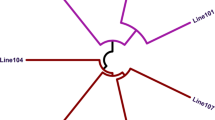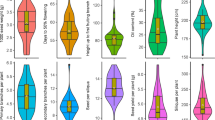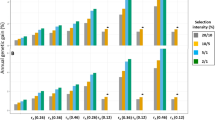Summary
Diallel analysis was applied to untransformed data for number of grains per ear in spring barley. Heterogeneity of variances was detected when the 13-parent diallel containing 2-row and 6-row genotypes, was analysed. This heterogeneity was found to be much reduced when the two subsets, containing only 2-row and only 6-row genotypes, were analysed. Analyses of variance from 9-parent full diallels at F1 for two seasons indicated significant differences between reciprocal crosses. Large and significant items for additive and non-additive genetic variance were detected. Significant effects for additive and non-additive variation were also detected when data from 13-parent half-diallels at F1 and F2 were analysed in both seasons. Graphical analysis of the 13-parent diallels revealed a high level of dominance with arrays of 2-row parents showing most dominance. Analysis of the 2-row populations revealed complete dominance acting in the direction of greater number of grains per ear. Tests for epistasis mostly failed to detect it but those interactions which did reach significance were generally of the duplicate type. Estimation of genetic components confirmed that a high level of dominance was operating in the inheritance of this character. Rather small effects for general and specific combining ability both for high and low numbers of grains per ear were detected, but significant positive correlations were found between the g.c.a. effects and the corresponding parental expression of the character. Significant interactions were detected between additive and non-additive effects at F1 and years in analyses conducted over both seasons.
Similar content being viewed by others
Article PDF
References
Aksel, R, and Johnson, L P V. 1961. Genetic studies on sowing-to-heading and heading-to-ripening periods in barley and their relation to yield and yield components. Can J Genet Cytol, 3, 242–259.
Grafius, J E. 1959. Heterosis in barley. Agron J, 51, 551–554.
Grafius, J E, Nelson, W L, and Dirks, V A. 1952. The heritability of yield in barley as measured by early generation bulked progenies. Agron J, 44, 253–257.
Griffing, J B. 1956. Concept of general and specific combining ability in relation to diallel crossing systems. Austral J Biol Sc, 9, 463–493.
Hayes, J D. 1965. A study of early generation assessment in cereals, with particular reference to barley. Ph.D. thesis, Univ. Wales.
Hayman, B I. 1954. The analysis of variance of diallel tables. Biometrics, 10, 235–244.
Hayman, B I. 1957. Interaction, heterosis and diallel crosses. Genetics, 42, 336–355.
Jinks, J L. 1954. The analysis of continuous variation in a diallel cross Nicotiana rustica varieties. Genetics, 39, 767–788.
Johnson, L P V, and Aksel, R. 1959. Inheritance of yielding capacity in a fifteen-parent diallel cross of barley. Can J Genet Cytol, 1, 208–265.
Mather, K. 1949. Biometrical Genetics. Methuen&Co., London.
Mather, K, and Jinks, J L. 1971. Biometrical Genetics. Chapman and Hall, London.
Mather, K, and Vines, A. 1952. The inheritance of height and flowering time in a cross of Nicotiana ructica. Quantitative Inheritance, ed. E. C. R. Reeve and C. H. Waddington, pp. 49–80. H.M.S.O. London.
Nilan, R A. 1964. The cytology and genetics of barley 1951–1962. Monographic Suppl. No. 3. Research Studies. Washington State University.
Riggs, T J, and Hayter, A M. 1972. Diallel analysis of the time to heading in spring barley. Heredity, 29, 341–357.
Thomas, R L, Grafius, J E, and Hahn, S K. 1971a. Genetic analysis of correlated sequential characters. Heredity, 26, 177–188.
Thomas, R L, Grafius, J E, and Hahn, S K. 1971b. Transformation of sequential quantitative characters. Heredity, 26, 189–193.
Whitehouse, R N H. 1968. Barley Breeding at Cambridge. Rep Pl Breed Inst, Cambridge, 1968, pp. 6–29.
Whitehouse, R N H, Thompson, J B, and de V Ribeiro, M A M. 1958. Studies on the breeding of self-pollinated cereals. 2. The use of a diallel cross analysis in yield prediction. Euphytica, 7, 147–169.
Author information
Authors and Affiliations
Rights and permissions
About this article
Cite this article
Riggs, T., Hayter, A. Diallel analysis of the number of grains per ear in spring barley. Heredity 31, 95–105 (1973). https://doi.org/10.1038/hdy.1973.61
Received:
Issue date:
DOI: https://doi.org/10.1038/hdy.1973.61
This article is cited by
-
Cross prediction studies on spring barley
Theoretical and Applied Genetics (1983)
-
The genetic control of morphological and yield characters in Vicia faba L.
Theoretical and Applied Genetics (1982)
-
The inheritance of diastatic power and alpha-amylase contents in spring barley
Theoretical and Applied Genetics (1978)
-
Inheritance of yield components and yield in relation to evidence for heterosis in F1 barley hybrids
Euphytica (1978)
-
A study of the inheritance and inter-relationships of some agronomically important characters in spring barley
Theoretical and Applied Genetics (1975)



